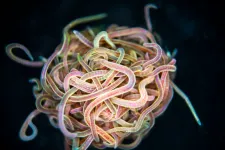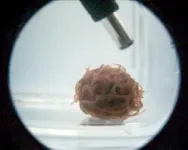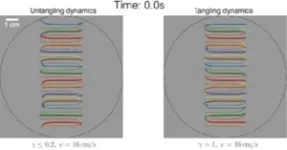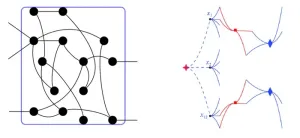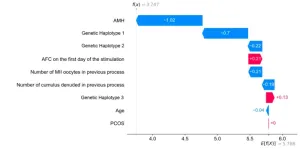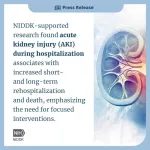(Press-News.org) For millennia, humans have used knots for all kinds of reasons — to tie rope, braid hair, or weave fabrics. But there are organisms that are better at tying knots and far superior — and faster — at untangling them.
Tiny California blackworms intricately tangle themselves by the thousands to form ball-shaped blobs that allow them to execute a wide range of biological functions. But, most striking of all, while the worms tangle over a period of several minutes, they can untangle in mere milliseconds, escaping at the first sign of a threat from a predator.
Saad Bhamla, assistant professor in the School of Chemical and Biomolecular Engineering at Georgia Tech, wanted to understand precisely how the blackworms execute their tangling and untangling movements. To investigate, Bhamla and a team of researchers at Georgia Tech linked up with mathematicians at MIT. Their research, published in Science, could influence the design of fiber-like, shapeshifting robotics that self-assemble and move in ways that are fast and reversible. The study also highlights how cross-disciplinary collaboration can answer some of the most perplexing questions in disparate fields.
Capturing the Inside of a Worm Blob
Fascinated by the science of ultrafast movement and collective behavior, Bhamla and Harry Tuazon, a graduate student in Bhamla’s lab, have studied California blackworms for years, observing how they use collective movement to form blobs and then disperse.
“We wanted to understand the exact mechanics behind how the worms change their movement dynamics to achieve tangling and ultrafast untangling,” Bhamla said. “Also, these are not just typical filaments like string, ethernet cables, or spaghetti — these are living, active tangles that are out of equilibrium, which adds a fascinating layer to the question.”
Tuazon, a co-first author of the study, collected videos of his experiments with the worms, including macro videos of the worms’ collective dispersal mechanism and microscopic videos of one, two, three, and several worms to capture their movements.
"I was shocked when I pointed a UV light toward the worm blobs and they dispersed so explosively," Tuazon said. "But to understand this complex and mesmerizing maneuver, I started conducting experiments with only a few worms."
Bhamla and Tuazon approached MIT mathematicians Jörn Dunkel and Vishal Patil (a graduate student at the time and now a postdoctoral fellow at Stanford University) about a collaboration. After seeing Tuazon’s videos, the two theorists, who specialize in knots and topology, were eager to join.
“Knots and tangles are a fascinating area where physics and mechanics meet some very interesting math,” said Patil, co-first author on the paper. “These worms seemed like a good playground to investigate topological principles in systems made up of filaments.”
A key moment for Patil was when he viewed Tuazon’s video of a single worm that had been provoked into the escape response. Patil noticed the worm moved in a figure-eight pattern, turning its head in clockwise and counterclockwise spirals as its body followed.
The researchers thought this helical gait pattern might play a role in the worms’ ability to tangle and untangle. But to mathematically quantify the worm tangle structures and model how they braid around each other, Patil and Dunkel needed experimental data.
Bhamla and Tuazon set about to find an imaging technique that would allow them to peer inside the worm blob so they could gather more data. After much trial and error, they landed on an unexpected solution: ultrasound. By placing a live worm blob in nontoxic jelly and using a commercial ultrasound machine, they were finally able to observe the inside of the intricate worm tangles.
“Capturing the inside structure of a live worm blob was a real challenge,” Tuazon said. “We tried all sorts of imaging techniques for months, including X-rays, confocal microscopy, and tomography, but none of them gave us the real-time resolution we needed. Ultimately, ultrasound turned out to be the solution.”
After analyzing the ultrasound videos, Tuazon and other researchers in Bhamla’s lab painstakingly tracked the movement of the worms by hand, plotting more than 46,000 data points for Patil and Dunkel to use to understand the mathematics behind the movements.
Explaining Tangling and Untangling
Answering the questions of how the worms untangle quickly required a combination of mechanics and topology. Patil built a mathematical model to explain how helical gaits can lead to tangling and untangling. By testing the model using a simulation framework, Patil was able to create a visualization of worms tangling.
The model predicted that each worm formed a tangle with at least two other worms, revealing why the worm blobs were so cohesive. Patil then showed that the same class of helical gaits could explain how they untangle. The simulations were uncanny in their resemblance to real ultrasound images and showed that the worms’ alternating helical wave motions enabled the tangling and the ultrafast untangling escape mechanism.
“What’s striking is these tangled structures are extremely complicated. They are disordered and complex structures, but these living worm structures are able to manipulate these knots for crucial functions,” Patil said.
While it has been known for decades that the worms move in a helical gait, no one had ever made the connection between that movement and how they escape. The researchers’ work revealed how the mechanical movements of individual worms determine their emergent collective behavior and topological dynamics. It is also the first mathematical theory of active tangling and untangling.
“This observation may seem like a mere curiosity, but its implications are far-reaching. Active filaments are ubiquitous in biological structures, from DNA strands to entire organisms,” said Eva Kanso, program director at the National Science Foundation and professor of mechanical engineering at the University of Southern California.
“These filaments serve myriads of functions and can provide a general motif for engineering multifunctional structures and materials that change properties on demand. Just as the worm blobs perform remarkable tangling and untangling feats, so may future bioinspired materials defy the limits of conventional structures by exploiting the interplay between mechanics, geometry, and activity.”
The researchers’ model demonstrates the advantages of different types of tangles, which could allow for programming a wide range of behaviors into multifunctional, filament-like materials, from polymers to shapeshifting soft robotic systems. Many companies, such as 3M, already use nonwoven materials made of tangling fibers in products, including bandages and N95 masks. The worms could inspire new nonwoven materials and topological shifting matter.
“Actively shapeshifting topological matter is currently the stuff of science fiction,” said Bhamla. “Imagine a soft, nonwoven material made of millions of stringlike filaments that can tangle and untangle on command, forming a smart adhesive bandage that shape-morphs as a wound heals, or a smart filtration material that alters pore topology to trap particles of different sizes or chemical properties. The possibilities are endless."
Georgia Tech researchers Emily Kaufman, Tuhin Chakrabortty, and David Qin contributed to this study.
CITATION: Patil, et al. “Ultrafast reversible self-assembly of living tangled matter.” Science. 28 April 2023.
DOI: https://www.science.org/doi/10.1126/science.ade7759
Writer: Catherine Barzler, Georgia Tech
Video: Candler Hobbs, Georgia Tech
Original footage and photography: Georgia Tech
Simulations: MIT
END
Unraveling the mathematics behind wiggly worm knots
2023-04-27
ELSE PRESS RELEASES FROM THIS DATE:
Information ‘deleted’ from the human genome may be what made us human
2023-04-27
New Haven, Conn. — What the human genome is lacking compared with the genomes of other primates might have been as crucial to the development of humankind as what has been added during our evolutionary history, according to a new study led by researchers at Yale and the Broad Institute of MIT and Harvard.
The new findings, published April 28 in the journal Science, fill an important gap in what is known about historical changes to the human genome. While a revolution in the capacity to collect data from genomes ...
Mammalian evolution provides hints for understanding the origins of human disease
2023-04-27
CHAPEL HILL, N.C. – Hundreds of scientific studies have been conducted over the years to find the genes underlying common human traits, from eye color to intelligence and physical and mental illnesses.
Patrick Sullivan, MD, FRANZCP, the Yeargan Distinguished Professor of Psychiatry and Genetics at the UNC School of Medicine, and the Psychiatric Genomic Consortium have produced a new packet for the journal Science, to give researchers another way to understand human disease, using the power of evolutionary genomics.
“This is a tool that can give us a lot of important hints about human disease,” ...
How dormant bacteria come back to life
2023-04-27
Solving a riddle that has confounded biologists since bacterial spores — inert, sleeping bacteria — were first described more than 150 years ago, researchers at Harvard Medical School have discovered a new kind of cellular sensor that allows spores to detect the presence of nutrients in their environment and quickly spring back to life.
It turns out that these sensors double as channels through the membrane and remain closed during dormancy but rapidly open when they detect nutrients. Once open, the channels allow electrically charged ions to flow out through the cell membrane, setting in motion ...
Collaborative and creative policies needed to maximize psychedelics’ therapeutic potential
2023-04-27
HOUSTON – (April 27, 2023) – Research supports the promise of psychedelics in treating conditions like depression and post-traumatic stress disorder, but the future regulatory landscape for these drugs remains unclear. Experts from Baylor College of Medicine, the University of Pennsylvania, American University and Harvard Law School call for creativity and collaboration at the federal and state levels in developing policies for the use and oversight of psychedelics and a commitment to developing a strong evidence base for efficacy and safety.
In a paper published in the journal Science, the authors, experts in bioethics, law and ...
Fish’s growth is not reduced by spawning
2023-04-27
Contrary to what is stated in biology textbooks, the growth of fish doesn’t slow down when and because they start spawning. In fact, their growth accelerates after they reproduce, according to a new article published in Science.
“Fish don’t have to choose between growth or reproduction because, in the real world, they don’t occur simultaneously but rather sequentially,” says University of British Columbia (UBC) fisheries researcher Dr. Daniel Pauly, co-author of ...
Local holographic transformations: tractability and hardness
2023-04-27
Counting problems arise in many different fields, e.g., statistical physics, economics and machine learning. In order to study the complexity of counting problems, several natural frameworks have been proposed. Two well studied frameworks are counting constraint satisfaction problems (#CSP) and Holant problems. For counting satisfaction problems over the Boolean domain, two explicit tractable families namely and , are identified; any function set which is not contained in these two families is proved to be #P-hard. Furthermore, counting CSPd is the counting constraint satisfaction problem restricted to the instances where every variable occurs a multiple of d times. The team ...
IVF procedures can be improved by combining genetic and clinical data to predict the number of eggs retrieved in patients undergoing ovarian stimulation
2023-04-27
IVF procedures can be improved by combining genetic and clinical data to predict the number of eggs retrieved in patients undergoing ovarian stimulation.
####
Article URL: https://journals.plos.org/ploscompbiol/article?id=10.1371/journal.pcbi.1011020
Article Title: Personalized prediction of the secondary oocytes number after ovarian stimulation: A machine learning model based on clinical and genetic data
Author Countries: Poland
Funding: The research was co-financed by the European Regional Development Fund under the ...
NRG Oncology study results confirm conventional external beam radiotherapy should remain standard of care in treating localized vertebral metastases of the spine
2023-04-27
Results from the NRG Oncology RTOG 0631 clinical trial comparing stereotactic vs. conventional radiotherapy for localized vertebral metastases of the spine did not meet its primary endpoint. Data from the study suggests that radiosurgery was not considered superior in terms of pain responses at 3 months following treatment, and even displayed worse pain response, than the conventional external beam radiotherapy (cEBRT). These results were recently published in the JAMA Oncology.
cEBRT is currently the standard of care for treating ...
Being hospitalized with acute kidney injury may increase risk for rehospitalization and death
2023-04-27
A study supported by the National Institutes of Health found that people who experienced acute kidney injury (AKI) during a hospitalization, including those admitted with AKI or who developed AKI in the hospital, were more likely to revisit the hospital or die shortly after discharge, compared to people hospitalized without AKI. AKI is a sudden loss of kidney function that usually lasts for a short time. The research, funded by NIH’s National Institute of Diabetes and Digestive and Kidney Diseases (NIDDK), was ...
Inflammation and cancer: Identifying the role of copper paves the way for new therapeutic applications
2023-04-27
Inflammation is a complex biological process that can eradicate pathogens and promotes repair of damaged tissues. However, deregulation of the immune system can lead to uncontrolled inflammation and produce lesions instead. Inflammation is also involved in cancer. The molecular mechanisms underlying inflammation are not fully understood, and so developing new drugs represents a significant challenge.
As far back as 2020, Dr. Raphaël Rodriguez, CNRS research director and head of the Chemical Biology team at Institut Curie (Equipe ...
